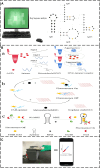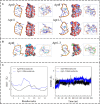Based on mutated aptamer-smartphone colorimetric detection of metronidazole in milk
- PMID: 39157440
- PMCID: PMC11327025
- DOI: 10.3389/fbioe.2024.1444846
Based on mutated aptamer-smartphone colorimetric detection of metronidazole in milk
Abstract
Excessive residue of metronidazole (MNZ) in food is harmful to the human body. There is an urgent demand to develop a portable tool for MNZ detection on-site. In this study, fifteen aptamers were prepared through targeted base mutation. Apt1-3 with the highest enrichment was chosen for further study. Its affinity was characterized by molecular docking simulation, AuNPs colorimetric assay, graphene oxide (GO) fluorescence assay, and exonuclease assay. Kd was determined by GO fluorescence assay (Kd: 92.60 ± 25.59 nM). Its specificity was also characterized by an exonuclease assay. A novel aptasensor was constructed by using the newly identified aptamer combined with the smartphone dark box. The principle of color change is caused by the aggregation state of AuNPs. Smartphones act as reading instruments. The detection can be completed in just a few seconds without the aid of instruments, achieving a detection limit of 0.15 nmol/mL and a range of 6.7-44.4 nmol/mL (R 2 = 0.9810). Therefore, the constructed smartphone colorimetric sensor based on mutant aptamers has important applications in food detection.
Keywords: aptamer; base mutation; colorimetric; metronidazole; smartphone.
Copyright © 2024 Zhang, Qin, Yuan, Wang, Yao and Zhang.
Conflict of interest statement
The authors declare that the research was conducted in the absence of any commercial or financial relationships that could be construed as a potential conflict of interest.
Figures






Similar articles
-
A Portable Smart-Phone Readout Device for the Detection of Mercury Contamination Based on an Aptamer-Assay Nanosensor.Sensors (Basel). 2016 Nov 8;16(11):1871. doi: 10.3390/s16111871. Sensors (Basel). 2016. PMID: 27834794 Free PMC article.
-
Preparation of DNA aptamer and development of lateral flow aptasensor combining recombinase polymerase amplification for detection of erythromycin.Biosens Bioelectron. 2021 Jun 1;181:113157. doi: 10.1016/j.bios.2021.113157. Epub 2021 Mar 13. Biosens Bioelectron. 2021. PMID: 33756378
-
A novel colorimetric aptasensor for detection of chloramphenicol based on lanthanum ion-assisted gold nanoparticle aggregation and smartphone imaging.Anal Bioanal Chem. 2019 Nov;411(28):7511-7518. doi: 10.1007/s00216-019-02149-7. Epub 2019 Oct 22. Anal Bioanal Chem. 2019. PMID: 31641824
-
Screening of a High-Affinity Aptamer for Aflatoxin M1 and Development of Its Colorimetric Aptasensor.J Agric Food Chem. 2023 May 17;71(19):7546-7556. doi: 10.1021/acs.jafc.3c01586. Epub 2023 May 5. J Agric Food Chem. 2023. PMID: 37144950
-
Screening of broad-spectrum aptamer and development of electrochemical aptasensor for simultaneous detection of penicillin antibiotics in milk.Talanta. 2024 Mar 1;269:125508. doi: 10.1016/j.talanta.2023.125508. Epub 2023 Dec 5. Talanta. 2024. PMID: 38070284
References
LinkOut - more resources
Full Text Sources
Research Materials
Miscellaneous

